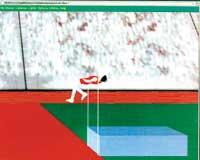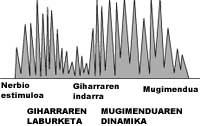New methods to improve height jump technique
The training techniques of athletes have changed radically. The main technique was the imitation of high-level athletes, currently more complex systems are used such as medical and psychological tests, food studies, biomechanical analysis, etc.
As is known, biomechanics studies body movement through the basic laws of mechanics and Leonardo da Vinci and Galileo, XV. and XVI. Prestigious scientists of centuries are considered pioneers of current biomechanics. With the aim of responding to different sports and thanks to the advances of computers, this science has developed remarkably and has become an essential tool to find the factors that influence the skill and technique of the athlete.

Under the coordination of the International Olympic Committee, CEIT and other international research centres have conducted biomechanical analyses of athletes who participated in the 1992 Barcelona Olympic Games. The information for the analysis was obtained through three video cameras. Then mathematical calculations were made to simulate the movement in the computer, which meant in addition to delving into the mechanics of some sports, obtaining spectacular animations.
Figure 1 shows one of the leaps made by Javier Sotomayor, owner of the world record. This article can be considered as a continuation of the research carried out then and also aims to be an aid to see how this type of calculations are made. For this we will develop a simple model of height jump analysis. This model explains that the movements of different parts of the body, muscle dynamics and neuromuscular relationships with each other, allow to perform complicated movements optimally and coordinated.
Height jump: basics of technique
As in any athletic test, in the height jump you have to overcome the forces of nature, in this case that of gravity, and it is about performing the sequence of movements that you have to perform to overcome the horizontal bar at a height.
The maximum height reached in the jump can be divided into three attack heights, flight height and free height. The attack height (H 1) is the height of the athlete's center of gravity at the time of attack. The flight height (H 2) is the difference between the maximum height reached by the center of gravity and the attack height. The flight height only depends on the vertical speed achieved by the athlete after the attack.
Finally, the free height (H 3) is the difference between the ribbon and the maximum height that reaches the center of gravity. For its part, the value of the free height depends on the speed of rotation that leads from the position of almost vertical attack to the position on the ribbon, almost horizontal, and the movements that the athlete must perform to pass without pulling the ribbon. Therefore, the free height depends on the athlete's jumping style.
In the development of the height jump technique different styles can be distinguished: scissors, belly, Fosbury, etc. Experience has shown that the “Fosbury” style is the most effective and used mostly by contemporary athletes. Therefore, it is what we will analyze in this article.
Biomechanical model
The movement the athlete makes at the time of the jump is very complex and therefore difficult to interpret. Therefore, the movement must be simplified in order to work better. However, the most important characteristics of movement must be maintained so that the result is correct.
In this case the athlete is represented through a system formed by three rigid elements (legs, thigh and trunk) that are joined in two joints (knee and hip) and the movement of the athlete is due to six muscle groups.
On the other hand, the equations corresponding to the mechanical model to be used can be obtained through usual methods in dynamic analysis: Newton equations, virtual working methods, etc.
Where the vectors of position, speed and acceleration of the coordinates describing the system 0, 0, 0, are the vector that forms the force of gravity F G and the vector of muscular force F M.

Each muscle is replaced by a system of three elements. The muscle itself consists of a recapitulative element (EL) that works parallel and a passive element (EP). The strength that the muscle can exert depends on its length, its speed of shortening and the muscle activity exercised by the nerves. The abbreviated element takes into account all these relationships, while the passive element represents the elastic characteristics of the muscle in distended conditions. In our case, the muscle is in series with the element (CE) that represents the tendon and is linearly elastic.
This practice greatly simplifies movement and also takes into account the interdependence between movement dynamics, muscle dynamics and neuromuscular relationship.
The input parameter to this model is the nervous stimulus over time and can be measured experimentally using electromyography techniques (EMG). By placing electrodes on the muscle surface, the graphic image of the electrical signals corresponding to muscle activations can be obtained. In this case, considering that the athlete's movements are instantaneous, it is assumed that the muscles acquire a great stimulus in a short space of time.
Formulation
If we analyze the chosen model, we observe that in the jump of the athlete intervene two types of variables:
Initial conditions: initial body angle with respect to ground 0 0, horizontal speed Vx 0, vertical speed Vy 0 and angular speed w 0, all measures at the time of attack. The values of these variables must be limited to be provided to human capacity.
Muscle excitation over time: nerve stimuli should be placed in a time interval, between the beginning of the stimulus t 1 and the end t 2.
If we provide all these variables with real values corresponding to a jump, the simulation of the jump can be obtained with the help of the computer and the value of the height exceeded. Moreover, mathematical optimization techniques allow obtaining optimal values for the initial conditions and nervous stimuli that are within the possibilities of the athlete.
This information is very useful for the athlete and, of course, also for the coach. With this tool, the athlete, in addition to knowing the characteristics that must correct, can know the combination of muscle forces to achieve an optimal jump.
Results
Figure 7 shows the model's optimized jump simulation with average characteristics of higher height jumpers. Athlete 1.9 meters high and 75 kg weight with a vertical speed in attack of 5 m/s. If we represent the simulation in a graphic way, we will see that it has great similarity with what higher height jumpers do in reality.
The athlete will exceed 2.42 m in height. In the upper table the different parts of the height are collected.

Study of the initial conditions: knowing that the free height is 2.5% of the total height, this component of the height can be rejected. That is, assuming that all the height that has exceeded is equal to that reached by the center of gravity of the athlete, we could approach the height that has exceeded the athlete through the formula of parabolic shooting. Therefore,
the height obtained in this case will depend on the initial height of the center of gravity and the vertical speed. In all tests performed, once the jump has been optimized, it has been confirmed that the height jumper uses the maximum vertical speed that can reach. This result is logical since the equation (2) shows that vertical speed is the most effective parameter at the height exceeded. The dependence on the initial height of the center of gravity also directly influences, hence making 0 = 90º.
Horizontal and vertical speed are less effective. The first hardly affects the height reached and its value is related to the interaction with the ground in attack, considered as 0.5-0.6 of the vertical speed. For its part, the value of the angular velocity should be such that the height jumper reaches a horizontal position on the ribbon.
Study of movement and muscles: the initially straight height jumper begins to rotate; as it approaches the ribbon, turn the hip and bend the knee. As soon as the hip exceeds the bar, the athlete leans sharply to the opposite side, raising the thigh up. When the back of the leg is near the bar, on the contrary, it will stretch the legs. The inclination of the hip and the stretch of the knee ensure the safety of the athlete when landing, adopting a position in “L”.
The evolution of the forces exercised by the various muscle groups considered can be seen in the graphs of Figure 8.
Conclusions
The method of analysis of the human movement presented in this article will condition future research, setting the new basis. Most of the studies carried out so far only took into account the dynamics of the skeleton. Here, on the contrary, the complex muscle structure and neuromuscular relationships have been taken into account, forming a simple and practical model that accurately describes the actual movement.
Height (m) | Percentage (%) | |
Attack | 1.08 |
|
Once the results of the studies are analyzed, the height jump is a very technical test. The height exceeded, in addition to depending on the instantaneous force of the attack leg that limits the take-off speed, is influenced by other characteristics such as body structure, elasticity and techniques of coordination of movements. Consequently, it can be said that strength, muscle power and general preparation of coordination between the different parts of the body are necessary to improve the level of the athlete.
Finally, to say that such an approach opens the door to other problems of all kinds, such as sport, rehabilitation or orthopedics.





